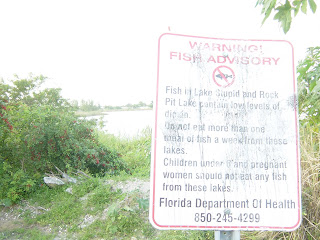
Superfund sites are the nation's worst toxic waste sites: 1,305 are scheduled for cleanup on the National Priorities List (NPL). About 11 million people in the U.S., including 3-4 million children, live within 1 mile of a federal Superfund site and confront potential public health risks. Scorecard profiles the risks these sites pose to public health and the environment. Scorecard ranks sites by how high they scored in EPA's Hazard Ranking System, and states and counties by number of Superfund sites.
The Wingate Superfund Site - Fort Lauderdale, Florida
Located at:
1300 N. W. 34TH AVENUE
FORT LAUDERDALE, Florida 33311

This picture was taken in 2007 at the Wingate Superfund Site - please note how close the house is to the site & the warning posted on the signs...Would you want your kids to play in the backyard if you lived here?
The Wingate Superfund site is an example of an environmental hazard to community residents. The rate of contamination and cases of cancer are more prevelant in Superfund site areas. The real estate in this area is significantly cheaper due to the potential health hazards. Most of the residents currently living in the area are unaware of the health hazards or they are unable to move due to their socioeconomic status.
Please visit the link below to learn more information & see historical facts about the Wingate Superfund Site...
The Wingate Incinerator Landfill Site
Geography 4900
By: Jeremiah Carter
Nova Southeastern University
A landfill is defined by Oxford dictionary as “waste material…used to landscape or reclaim areas of ground…the process of disposing rubbish…a place where rubbish is disposed of by burying it in the ground (1998, p.455)” Due to the hazardous material found in the landfill, Fort Lauderdale, Florida is the home of a large superfund site. There are many other superfund sites in the United States of America. Broward County so unique is that it is surrounded by a residential zoned area. The Wingate Road Incinerator Landfill Site is located at 1300 NW 31st Avenue, Fort Lauderdale Florida. It has been deemed a superfund site because government funds were used to establish this long-term expensive hazardous waste storage/incineration project.
This site is currently owned by the city of Fort Lauderdale, and while it is located in a residential area, it is zoned for commercial and industrial land uses. At approximately 61 acres in size, this incinerator site was operated from 1954-1978; after 1978, incineration of waste materials ceased. The fumes and smoke from the burnt waste bothered the wealthier residents of the City of Plantation, and complaints were lodged. Unfortunately, the less privileged residents of Ft. Lauderdale that live in the surrounding area of this waste site don’t seem to be aware of the dangers of living near a hazardous waste superfund site. There are nearly 466,000 Ft. Lauderdale residents currently living within a 4 mile radius of the Wingate Road landfill.
Despite the regulations set by government officials, this superfund site has raised many concerns due to the potential hazardous waste that can cause various health hazards to residents in the area. Even with remediation tactics, methane monitoring, including soil and ground water studies, the concern is that the site’s protective cap and remediation methods are not enough to protect human health and the surrounding environment.
In 1985 the EPA conducted a site inspection and developed a Hazardous Ranking System Report. In 1989 the Wingate Road Incinerator Landfill site was declared a superfund site. Once the landfill cap was constructed the System Operation/Operation and Maintenance (O&M) began to perform various routine activities such as: Site inspections, surface water management, ground water monitoring, ground water monitoring system maintenance, and gas control system maintenance (The Five-Year Review Report, 2005). One major advantage if placing a cap on the superfund site is to minimize infiltration of water into the waste materials located below the cap and monitor the release of toxic gases. A major disadvantage to this plan is the abstinence of a liner below the waste material to prevent leakage into the water and soil. As stated in the Five year review report: “Erosion at the base of the landfill can also threaten side slope stability (2005, p. 7).” There is the presence of methane gas, dioxins, arsenic, antimony, cadmium, and lead at the Wingate Superfund site.
History has shown that those in the lower socioeconomic status are at a higher risk of exploitation in America. The Wingate Road Municipal Incinerator Dump is a prime example of such exploitation. Ironically, the name Wingate Road has been changed to Martin Luther King, Jr. Boulevard to honor the very prominent civil rights leader. The surrounding populations of almost 466,000 Ft. Lauderdale residents who live within a 4 mile radius of the landfill are mainly lower economic class minorities.
Given the reaction in 1978 of ceasing incineration when the City of Plantation residents complained, it is unlikely that a superfund site such as the Wingate Incinerator Dump would be located in an upper-class, predominantly white neighborhood. Would this superfund site be held to higher standards if it were in an upper-class, predominantly white neighborhood? Would there be more publications and awareness of the potential hazards associated with living in the area if it were located in an upper-class, predominantly white neighborhood?
The majority of the citizens in the area are so preoccupied with meeting their financial needs on a daily basis that they do not have the time and/or proper education about the hazardous contaminants in the superfund site located in their community. For some residents, this superfund site is located in their backyards. Community involvement is very important. The city of Fort Lauderdale is responsible for posting periodical information to notify the current and future residents of the potential hazards of this area. The community was notified about the five year review in a 2004 by an article in the Sun-Sentinel newspaper. Yet, the majority of residents are unaware of the health hazards associated with this superfund site. In the Five Year Review Process it states that there is adequate perimeter fencing.
When I visited the area in November of 2007, there were many areas with no barrier to the surrounding bodies of water. The two bodies of water located on the site are named Rock Pit Lake and Lake Stupid. Surface water runoff collects in a series of ditches and is channeled to these bodies of water. There is no fence to protect any residents from fishing or swimming in either body of water. This raised a big concern for the safety of the children that may swim in this contaminated water. The signs were outdated, eroded, and even missing is some areas.
I randomly and informally interviewed some residents in the area, and none of them seemed to know what a superfund site was, that the enormous landfill was a superfund site, or that it posed a health hazardous danger to them and their loved ones. It is easy to see why the residents are not aware of the danger to their health and well-being when you look at the posted signage. The warning signs posted by Ft. Lauderdale were outdated, the lettering/print was eroded and dirty…making the posted signage difficult to read, even if you tried.
The sign in Lake Stupid read as follows: “Warning! Fish Advisory – Fish in Lake Stupid & Rock Pit Lake contain low levels of dioxin. Do not eat more than one meal of fish a week from these lakes. Children under 6 and pregnant women should not eat any fish from these lakes. – Florida Department of Health (850) 245-4299.” This advisory in not sufficient when considering the potential health hazards if someone were to swim or eat the fish that are in these bodies of water.
During my tour of the surrounding superfund residential area, I noticed that some lots were empty with a sign that stated they were owned by the city of Fort Lauderdale. Yet, the next lot has a dilapidated or very old looking house on it. If the city of Fort Lauderdale is sincerely concerned about all of its residents, no matter their race, color, or creed; then more signs need to be posted in the area. There should be new fencing constructed around these hazardous bodies of water. There should be more articles, notices, and education material of the superfund site available to the community residents. All humans are created equal and the United States Government Constitution reflects this fact, lets honor those words and implement a remedial plan that will ensure the positive health and well-being of all Broward county residents, no matter their race or socioeconomic status.
References:
Banister, B. (Ed.). (2005). First Five-Year Review Report. In Wingate Road Incinerator Landfill Site United States Environmental Protection Agency.
Metcalf, J. (Ed.). (1998). In Oxford Dictionary New York: DK Publishing, Inc.













